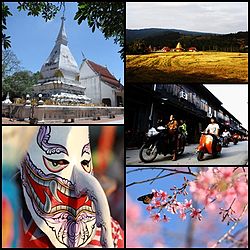Loei province
province in Northeastern Thailand From Wikipedia, the free encyclopedia
Remove ads
Loei (Thai: เลย, pronounced [lɤ̄ːj]), is one of the least populated provinces (changwat) of Thailand. It is in upper northeastern Thailand, also called Isan. Neighboring provinces are (from east clockwise) Nong Khai, Udon Thani, Nongbua Lamphu, Khon Kaen, Phetchabun, Phitsanulok. In the north it borders Xaignabouli and Vientiane Province of Laos.
Remove ads
As of 2020[update], the provincial governor is Chaiwat Chuenkosum.[4] The province was given 225.6 million baht in the FY2019 Thailand budget.[5]
Remove ads
History
Tradition says that Loei was created by people from Chiang Saen, the capital of Lan Na. Khun Pha Muang created the village of Dan-kwa, and Bang Klang Hao created Dan Sai. Drought and disease later made to the people move to the site of present-day Loei. In 1907 King Chulalongkorn (Rama V) created the Loei Province. The Loei Cultural Centre (ศูนย์วัฒนธรรมจังหวัดเลย) shows Loei's history, religions, and traditions.[6]
Remove ads
Geography

The land has many mountains. The seat of provincial government, Loei, is in a fertile basin where mountains are all around it. The most famous mountains in the province are Phu Kradueng, Phu Luang, and Phu Ruea. The Loei River, which flows through the province, is a tributary of the Mekong, which creates part of the northern border of the province with neighboring Laos. Phu Thap Buek, the tallest mountain of the Phetchabun Range, is in the province.[7]
The mountain Phu Kradueng is in Phu Kradueng National Park (อุทยานแห่งชาติภูกระดึง).[8]
The western part of the province reaches the southern end of the Luang Prabang Range mountain area of the Thai highlands.[9]
Remove ads
Economy
Agriculture is an important part of Loei's economy. Macadamia nuts, passion fruit, and Arabica coffee are grown in the highlands; bananas, sesame, and rubber are grown on the plains. Loei is a popular place for tourists who want to look at the environment. This is because of Loei's natural environment and amalgam of northern and northeastern cultures.[10]
Wang Saphung District has a big open pit gold mine that employs many people. The area has been the place of a long-standing disagreement as well as fights between the people of Ban Na Nong Bong and its environs and Tungkum Limited, a subsidiary of Tongkah Harbour PCL. Tungkum's gold mining work has been accused of environmental destruction in the courts.[11]
Government
Provincial government
The province is divided into 14 districts (amphoe). The districts are further divided into 89 subdistricts (tambons) and 839 villages (mubans).
|
|
Local government
As of 26 November 2019 there are:[12] one Loei Provincial Administration Organisation (ongkan borihan suan changwat) and 29 municipal (thesaban) areas in the province. Loei with Wang Saphung have town (thesaban mueang) status. Further 27 subdistrict municipalities (thesaban tambon). The non-municipal areas are governed by 71 Subdistrict Administrative Organisations - SAO (ongkan borihan suan tambon).[2]
Remove ads
Transportation
Route 201 comes from Chiang Khan in the north on the border with Laos. It goes through Loei, to Non Sa-at near Chum Phae. Route 203 leads west to the area of Phu Ruea, and then turns south to Lom Sak.
Symbols
The seal of the province shows the stupa at Phra That Si Song Rak, which was built in 1560 by King Maha Chakrapat of the Ayutthaya Kingdom and King Chai Chetha of Lan Xang. It was built as a symbol of friendship between the two kingdoms.[14] The provincial tree is the Khasi pine (Pinus kesiya).
The slogan of the province is "city of the sea of mountains, coldest place in Siam, with beautiful flowers of three seasons."[15]
Remove ads
Human achievement index 2017
| Health | Education | Employment | Income |
| 75 | 46 | 15 | 49 |
| Housing | Family | Transport | Participation |
 |
 |
 |
|
| 24 | 16 | 56 | 16 |
| Province Loei, with an HAI 2017 value of 0.5819 is "average", occupies place 42 in the ranking. | |||
Since 2003, United Nations Development Programme (UNDP) in Thailand has watched progress on human development for the provinces using the Human achievement index (HAI). The HAI is a list including all the eight key areas of human development. National Economic and Social Development Board (NESDB) has taken over this job since 2017.[3]
| Rank | Classification |
| 1 - 15 | "high" |
| 16 - 30 | "somewhat high" |
| 31 - 45 | "average" |
| 45 - 60 | "somewhat low" |
| 61 - 77 | "low" |
| Map with provinces and HAI 2017 rankings |
 |
Remove ads
Notes
Reports (data) from Thai government are "not copyrightable" (Public Domain), Copyright Act 2537 (1994), section 7.
References
Other websites
Wikiwand - on
Seamless Wikipedia browsing. On steroids.
Remove ads





